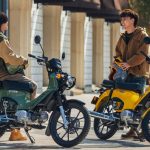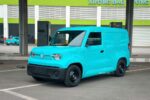Bicycles and motorbikes used to be the primary modes of transportation in South Vietnam before 1975, and they still remain popular today. This article offers a comprehensive overview of the motorbikes that were prevalent in the region before 1975.
You can share your thoughts on this article at http://www.facebook.com/Autodaily
Before 1975, what did people in Saigon ride? (Part 1)
Before 1975, what did people in Saigon ride? (Part 2)
The presence of the “big four”
All four major Japanese motorcycle manufacturers – Honda, Yamaha, Suzuki, and Kawasaki – had a presence in South Vietnam before 1975.
Suzuki introduced male models M15 and M12, as well as female models Suzuki Dame and M31. The two male models were quite similar, using the same engine, but the sporty model featured a higher exhaust pipe and a shorter front fender, giving it a more athletic appearance.
Yamaha had two male models, including the YF5 model, and a female model called Yamaha Dame. Yamaha’s male models were known for their shiny parts and attractive design. The Yamaha Dame, painted in sky blue with gentle curves, had an artistic aesthetic. However, Yamaha motorcycles were less popular than Honda motorcycles due to their slightly less powerful engines.
The Suzuki Dame and Yamaha Dame had lower headlights compared to the Honda Dame, giving them a more graceful appearance that suited girls wearing traditional ao dai dresses.
Kawasaki was the smallest Japanese motorcycle manufacturer at that time, offering only one male model. Kawasaki motorcycles performed well but received criticism for being heavy and having weak engines. The motorcycles brought to Vietnam were the 80cc frame type, which were later modified with a 50cc engine to be classified as mopeds, exempt from requiring a license.
A less well-known brand is Bridgestone.
Bridgestone specialized in tire manufacturing but also had a division that produced racing motorcycles. The Bridgestone model introduced in Vietnam in 1966 had a 65cc engine, making Bridgestone motorcycles quite powerful. They were known for their four-speed gearbox, similar to racing motorcycles. When in fourth gear, pressing the gear again would shift back to the first gear without going in reverse. However, Bridgestone motorcycles lost popularity among the Vietnamese people when the motorcycle division of the company closed in 1967 due to other Japanese motorcycle manufacturers’ unwillingness to purchase tires from their competitors.
Japanese motorcycles dominate in Saigon
Unlike European motorcycle manufacturers, who maintained the same models for many years, Japanese manufacturers aggressively introduced new models every year to the Vietnamese market. In 1968, Honda launched the CL50 model, with “CL” standing for Scrambler. The motorcycle was designed for riding on uneven dirt roads and featured four gears, strong acceleration in the first and second gears, and a lower top speed compared to the Honda 67. The tall exhaust pipe aimed to prevent collisions with the ground or water.
In 1969, Honda introduced the SS50M model, which shared the same engine and frame as the Honda 67 but had a longer fuel tank for a sportier appearance. In 1970, Honda introduced the CD50 model, another variant using the SS50’s frame and engine but featuring a different fuel tank and storage box design, giving it a distinct look. The CD50 was designed for urban riding and had four gears with strong acceleration in the lower gears, making it suitable for stop-and-go traffic in the city.

Using the SS50E model, Honda introduced new models in 1971 and 1972 with metallic red paint, shiny fenders, and high handlebars resembling bull horns, making them more appealing. Honda changed the exterior appearance to attract new customers. In 1969, Suzuki also introduced the AS50 model, which had a sporty and beautiful design. In addition to officially imported Honda models, rare Honda models such as the tiny Honda Monkey or the Honda CT50 and CT70, where “CT” stood for Trail, were occasionally seen on the streets of Saigon. Although designed for leisure rides in the countryside, they became a means of transportation for school and work in Vietnam.

Among all Japanese motorcycles, only Honda used a four-stroke engine with separate fuel and oil compartments. Other brands used two-stroke engines that ran on mixed fuel and oil.
With a wide variety of motorcycles available, the streets of South Vietnam became vibrant with colorful motorcycles. Saigon’s streets were filled with motorcycles, revving engines, and the sound of excitement. Honda motorcycles were known for their quiet operation. However, many users removed the noise suppressor at the end of the exhaust pipe, resulting in louder engine noise. This suppressor was a small tube with holes, about the length of an arm. By removing a small screw at the end of the exhaust pipe, users found that their motorcycles ran faster without the suppressor.
From small motorcycles…
As the number of motorcycles increased in Saigon, the city became more dangerous due to the high speed and quick acceleration of Japanese motorcycles. Concerned parents were hesitant to purchase powerful motorcycles for their children. In response, Honda introduced the PC50 model. The PC50 used a 50cc engine, didn’t require shifting gears, and had less acceleration compared to motorcycles with gears. Its top speed was around 60 km/h. The PC50 was an improved version of the P50, with the engine placed in the middle for better balance and suspension in both the front and rear wheels. Using the PC50 was as simple as riding a Mobylette: just kick-start the engine and twist the throttle.
Motobécane also introduced the small and compact Cady model, suitable for students. The name “Cady” may come from the word “Cadet,” indicating that it was the youngest model in the Motobécane family. Although it also used a 50cc engine, the motorcycle could only reach a maximum speed of 40 km/h. The motorcycle’s slow speed may seem like a disadvantage, but it was actually an advantage for parents who wanted to ensure their children’s safety. In the early 1970s, Cady motorcycles were initially painted brown or gray but later appeared in various bright colors like blue, red, and yellow. Alongside the mini skirts trend, the streets of Saigon saw the emergence of mini Cady motorcycles with two small wheels, which looked incredibly cute. At the same time, mini bicycles also became popular, and teenage girls wearing mini ao dai dresses appeared youthful and vibrant as they rode colorful mini motorcycles.
…to “brave highways”
The Bien Hoa Highway, now known as Hanoi Highway, had very few vehicles at that time, making it a testing and racing ground for motorcycles. Motorcycle enthusiasts would bring out various types of motorcycles to test their top speeds during off-peak hours. Although there were no formal reviews or ratings of motorcycles, the advantages and disadvantages of each type were widely shared through word of mouth. Two-stroke motorcycles, while fast-running, would become weaker and slower at high speeds after continuous hours of operation. Only Honda motorcycles after 1965 received praise for maintaining their speed even when running at high temperatures. Honda improved the lubrication system, injecting more oil into the engine to prevent slowdown caused by friction. Other Honda models such as the S65 and C110, while capable of reaching speeds of over 100 km/h, also experienced slight performance degradation when running hot.
In an effort to increase motorcycle power, the pistons were often modified to increase the displacement from 50cc to 60cc or 70cc. Motorcycles with modified pistons could achieve higher speeds of over 100 km/h if the engine was properly tuned.
A popular game among motorcycle enthusiasts was known as “beating the be.” The term “be” referred to a wooden stick measuring five or six meters in length. One end of the stick was tied to the front of a cargo bike, while the other end was attached to the rear trailer, leaving no other connection between the cargo bike and the rear trailer. The distance from the stick to the road surface was just over one meter. Racers would attempt to crawl under the cargo bike from one side to the other. Due to the low height, they couldn’t ride straight and had to tilt the motorcycle to pass through. If they miscalculated the timing, they risked being hit and run over by the rear wheels.
Motorcycles served as a means of transportation, but they also symbolized the speed-loving youth and demonstrated the allure of colors, styles, and engine sounds. This passion for motorcycles remains etched in the memories of many people in South Vietnam, serving as a beautiful reminder of the excitement when bringing home a brand new motorcycle and the days spent traveling on iron horses.
Th? Ð?t (Source: PL&XH/Ngu?n: Honda67)




















































